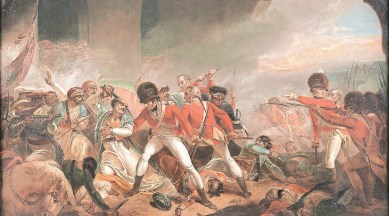Stay updated with the latest - Click here to follow us on Instagram
At DAG from Monday: 18th Century paintings of Tipu Sultan, Anglo-Mysore wars to go on display
In an eponymous exhibition that opens at DAG, The Claridges on July 25, Giles Tillotson has put together several famed paintings of the time alongside maps depicting war positions and the Mysore cityscape sketched and painted during the period.

In the 18th Century, as the Anglo-Mysore Wars played out between the British East India Company and the Kingdom of Mysore, a curious British audience was keeping track of the development miles away. While channels of communication provided information, Giles Tillotson, Senior VP (Exhibitions and Publications), DAG, notes how artists fed a public appetite for images relating to Mysore ruler Tipu Sultan on a scale that was unsurpassed by any other comparable figure. In the book, Tipu Sultan: Image & Distance, Tillotson writes, “Whatever else can be said about Tipu Sultan, he had an unrivalled career as a subject of British history painting.”
In an eponymous exhibition that opens at DAG, The Claridges on July 25, Tillotson has put together several famed paintings of the time alongside maps depicting war positions and the Mysore cityscape sketched and painted during the period. Coming from the DAG collection, the showcase presents depictions of war as well as the times, presenting how the battle was interpreted by foreign as well as local artists. Among the highlights is Henry Singleton’s The Last Effort and Fall of Tippoo Sultan. The 1802 canvas depicts Tipu Sultan’s inability to fight the British despite his might, and a British officer beside him plunging a dagger into Tipu as he falls. Tillotson notes, “All of this is entirely imaginary: no one on the British side saw the moment when Tipu fell in battle… he was more likely killed by a distant shot than a close encounter.”
According to Tillotson, Robert Ker Porter’s depiction of the war in the 1800 work Finding the Body of Tippoo Sultan was closer to the narratives offered at the time. One of the best-known depictions of the fall of Srirangapatna, meanwhile, he writes, was Robert Ker Porter’s triptych The Last Effort of Tippoo Sultan in Defence of the Fortresses of Seringapatam — The Storming of Seringapatam—The Glorious Conquest of Seringap-atam. The exhibition features an engraved print of the painting by John Vendramini. “Tipu Sultan is shown on the ramparts on the left; while General Baird commands the assault on the breach, in the centre,” writes Tillotson.
There are also accounts by eyewitnesses. The exhibition includes Robert Homes’ views of Mysore. The official artist of the Third Mysore War, he accompanied the armies under Lord Cornwallis at the sieges of Bangalore and Srirangapatna and the surrender of Tipu Sultan’s sons as hostages in 1792. Also on view are three editions of the English newspaper The Northampton Mercury, carrying reports and descriptions of the war.
Speaking about the curation and the collection, Tillotson notes, “As much through engraved versions as the originals, these works are well known and they have been surveyed and illustrated before — but not always, I think, in ways that are alert to details of the development of history painting in England and France in the period. I locate them between a previously established type, which aimed to illustrate episodes exemplifying heroic virtue, and a newly emerging type of war painting. More importantly, the works and the attitudes that they are shown to embody, originally directed towards a British public, are here presented for scrutiny for the first time specifically to audiences in India.”